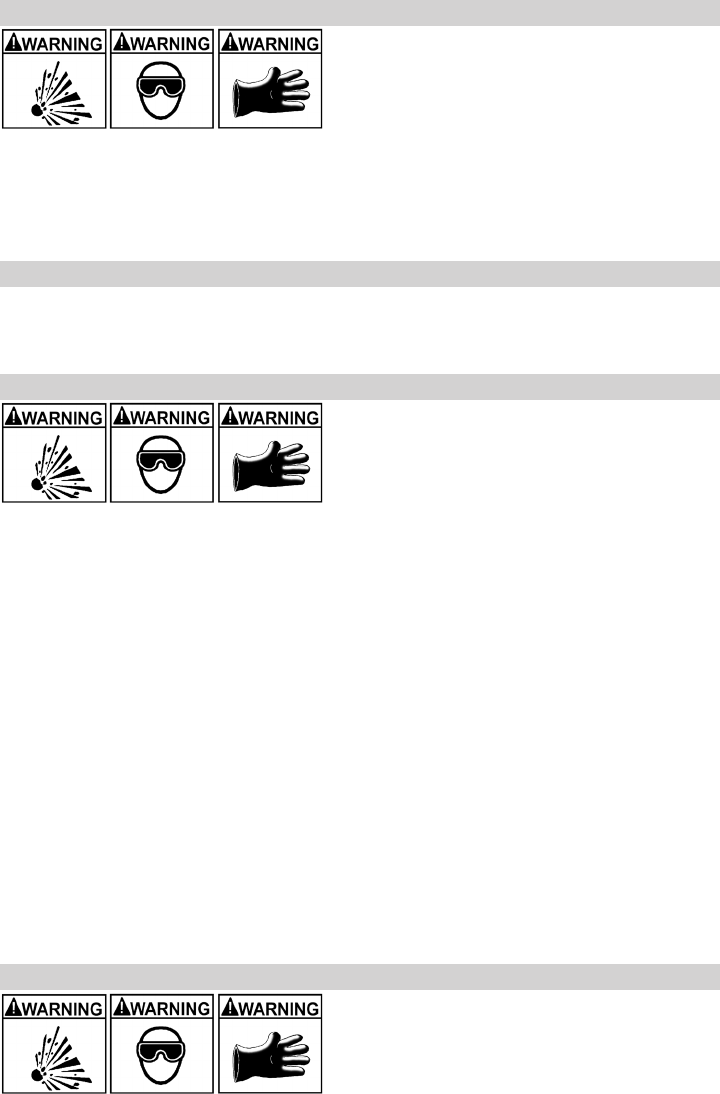
• 3 •
CHARGER LOCATION4.
RISK OF EXPLOSION AND CONTACT WITH
BATTERY ACID.
Locate the charger as far away from the 4.1
battery as the DC cables permit.
Never place the charger directly above the 4.2
battery being charged; gases from the battery will
corrode and damage the charger.
Do not set the battery on top of the charger.4.3
Never allow battery acid to drip onto the charger when reading the electrolyte specic 4.4
gravity or lling the battery.
Do not operate the charger in a closed-in area or restrict the ventilation in any way.4.5
DC CONNECTION PRECAUTIONS5.
Connect and disconnect the DC output clips only after setting all of the charger switches 5.1
to the “off” position (if applicable) and removing the AC plug from the electrical outlet.
Never allow the clips to touch each other.
Attach the clips to the battery and chassis, as indicated in sections 6 and 7.5.2
FOLLOW THESE STEPS WHEN BATTERY IS INSTALLED IN VEHICLE6.
A SPARK NEAR THE BATTERY MAY CAUSE A
BATTERY EXPLOSION. TO REDUCE THE RISK
OF A SPARK NEAR THE BATTERY:
Position the AC and DC cables to reduce the 6.1
risk of damage by the hood, door and moving or hot
engine parts. NOTE: If it is necessary to close the
hood during the charging process, ensure that the hood does not touch the metal part of
the battery clips or cut the insulation of the cables.
Stay clear of fan blades, belts, pulleys and other parts that can cause injury.6.2
Check the polarity of the battery posts. The POSITIVE (POS, P, +) battery post usually 6.3
has a larger diameter then the NEGATIVE (NEG, N, -) post.
Determine which post of the battery is grounded (connected) to the chassis. If the 6.4
negative post is grounded to the chassis (as in most vehicles), see step 6.5. If the
positive post is grounded to the chassis, see step 6.6.
For a negative-grounded vehicle, connect the POSITIVE (RED) clip from the battery 6.5
charger to the POSITIVE (POS, P, +) ungrounded post of the battery. Connect the
NEGATIVE (BLACK) clip to the vehicle chassis or engine block away from the battery.
Do not connect the clip to the carburetor, fuel lines or sheet-metal body parts. Connect
to a heavy gauge metal part of the frame or engine block.
For a positive-grounded vehicle, connect the NEGATIVE (BLACK) clip from the battery 6.6
charger to the NEGATIVE (NEG, N, -) ungrounded post of the battery. Connect the
POSITIVE (RED) clip to the vehicle chassis or engine block away from the battery. Do
not connect the clip to the carburetor, fuel lines or sheet-metal body parts. Connect to a
heavy gauge metal part of the frame or engine block.
Connect charger AC supply cord to electrical outlet.6.7
When disconnecting the charger, turn all switches to off, disconnect the AC cord, remove 6.8
the clip from the vehicle chassis and then remove the clip from the battery terminal.
See CALCULATING CHARGE TIME for length of charge information.6.9
FOLLOW THESE STEPS WHEN BATTERY IS OUTSIDE VEHICLE7.
A SPARK NEAR THE BATTERY MAY CAUSE A
BATTERY EXPLOSION. TO REDUCE THE RISK
OF A SPARK NEAR THE BATTERY:
Check the polarity of the battery posts. The 7.1
POSITIVE (POS, P, +) battery post usually has a
larger diameter than the NEGATIVE (NEG, N, -) post.
Attach at least a 24-inch (61 cm) long 6-gauge (AWG) insulated battery cable to the 7.2
NEGATIVE (NEG, N, -) battery post.


















